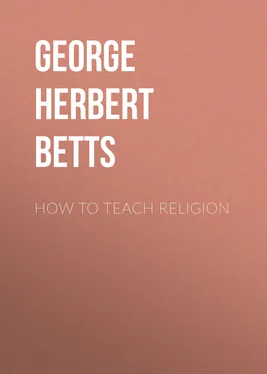George Herbert Betts - How to Teach Religion
Здесь есть возможность читать онлайн «George Herbert Betts - How to Teach Religion» — ознакомительный отрывок электронной книги совершенно бесплатно, а после прочтения отрывка купить полную версию. В некоторых случаях можно слушать аудио, скачать через торрент в формате fb2 и присутствует краткое содержание. Жанр: foreign_prose, Религиозная литература, foreign_religion, foreign_edu, foreign_antique, на английском языке. Описание произведения, (предисловие) а так же отзывы посетителей доступны на портале библиотеки ЛибКат.
- Название:How to Teach Religion
- Автор:
- Жанр:
- Год:неизвестен
- ISBN:нет данных
- Рейтинг книги:5 / 5. Голосов: 1
-
Избранное:Добавить в избранное
- Отзывы:
-
Ваша оценка:
- 100
- 1
- 2
- 3
- 4
- 5
How to Teach Religion: краткое содержание, описание и аннотация
Предлагаем к чтению аннотацию, описание, краткое содержание или предисловие (зависит от того, что написал сам автор книги «How to Teach Religion»). Если вы не нашли необходимую информацию о книге — напишите в комментариях, мы постараемся отыскать её.
How to Teach Religion — читать онлайн ознакомительный отрывок
Ниже представлен текст книги, разбитый по страницам. Система сохранения места последней прочитанной страницы, позволяет с удобством читать онлайн бесплатно книгу «How to Teach Religion», без необходимости каждый раз заново искать на чём Вы остановились. Поставьте закладку, и сможете в любой момент перейти на страницу, на которой закончили чтение.
Интервал:
Закладка:
These are all fair questions, for knowledge is without meaning except as it becomes a guide to action. High ideals and beautiful enthusiasms attain their end only when they have eventuated in worthy deeds. What we do because of our training is the final test of its value. Conduct, performance, achievement are the ultimate measures of what our education has been worth to us. By this test we must measure the effects of our teaching.
Summary of the threefold aim.—The aim in teaching the child religion is therefore definite, even if it is difficult to attain. This aim may be stated in three great requirements which life itself puts upon the child and every individual:
1. Fruitful knowledge ; knowledge of religious truths that can be set at work in the daily life of the child now and in the years that lie ahead.
2. Right attitudes ; the religious warmth, responsiveness, interests, ideals, loyalties, and enthusiasms which lead to action and to a true sense of what is most worth while.
3. Skill in living ; the power and will to use the religious knowledge and enthusiasms supplied by education in shaping the acts and conduct of the daily life.
True, we may state our aim in religious teaching in more general terms than these, but the meaning will be the same. We may say that we would lead the child to a knowledge of God as Friend and Father; that we seek to bring him into a full, rich experience of spiritual union with the divine; that we desire to ground his life in personal purity and free it from sin; that we would spur him to a life crowned with deeds of self-sacrifice and Christlike service; that we would make out of him a true Christian. This is well and is a high ideal, but in the end it sums up the results of the religious knowledge, attitudes , and acts we have already set forth as our aim. These are the parts of which the other is the whole; they are the immediate and specific ends which lead to the more distant and general. Let us, therefore, conceive our aim in both ways—the ideal Christian life as the final goal toward which we are leading, and the knowledge, attitudes, and acts that make up to-day's life as so many steps taken toward the goal.
After the aim the subject matter. When we would build some structure we first get plan and purpose in mind; then we select the material that shall go into it. It is so with education. Once we have set before us the aim we would reach, our next question is, What shall be the means of its attainment? When we have fixed upon the fruitful knowledge, the right attitudes, and the lines of conduct and action which must result from our teaching, we must then ask, What means shall we select to achieve these ends? What material or subject matter shall we teach in the church school?
The subject matter he presents is the instrumentality by which the teacher must accomplish his aims for his class. Through this material he must awaken thought, store the mind with vital truths, arouse new interests, create ideals and lead the life to God. As the artist works with brush and paint, with tool and clay, so the teacher must work with truths and lesson materials.
Guiding principles.—Two great principles must guide in the selection of subject matter for religious instruction:
1. The material must be suited to the aims we seek.
2. The material must be adapted to the child.
The tools and instruments the workman uses must be adapted to the purpose sought. Ask the expert craftsman what kind of plane or chisel you should buy for a piece of work you have in mind, and he will ask you just what ends you seek, what uses you would put them to. Ask the architect what materials you should have for the structure you would build, and he will tell you that depends on the plan and purpose of your building.
The material must fit the aim.—What materials of religious truth should the teacher bring to his class? The answer is that truths and lessons must be suited to the aim we seek. Would we lead our children to understand the Fatherhood of God and to love him for his tender care? Then the lessons must contain this thought, and not be built on irrelevant material. Would we lead youth to catch the thrill and inspiration of noble lives, to pattern conduct after worthy deeds? Then our lesson material must deal with the high and fine in character and action, and not with trivial things of lesser value.
So also, if we would capture the interest of childhood for the church school and bind its loyalty to the church, the subject matter we offer and the lessons we teach in the house of God must contain the glow and throb of life, and not be dry and barren. If we would awaken religious feeling and link the emotions to God, we must not teach empty lessons, meaningless dates, and musty facts that fail to reach the heart because they have no inner meaning.
Small use to set high aims and then miss them for want of material suited for their attainment. Small use to catalogue the fine qualities of heart and mind we would train in our children and then fail of our aim because we choose wrong tools with which to work. Not all facts found in the Bible are of equal worth to children, nor are all religious truths of equal value. Nothing should be taught just because it is true , nor even because it is found in the Bible. The final question is whether this lesson material is the best we can choose for the child himself; whether it will give him the knowledge he can use, train the attitudes he requires, and lead to the acts and conduct that should rule his life.
The material must fit the child.—The subject matter we teach must also be fitted to the child . It must be within his grasp and understanding. We do not feed strong meat to babes. What may be the grown person's meat may be to the child poison. It does no good to load the mind with facts it cannot comprehend. There is no virtue in truths, however significant and profound, if they are beyond the reach of the child's experience. Matter which is not assimilated to the understanding is soon forgotten; or if retained, but weighs upon the intellect and dulls its edge for further learning.
There can be little doubt that we have quite constantly in most of our Sunday schools forced upon the child no small amount of matter that is beyond his mental grasp, and so far outside his daily experience that it conveys little or no meaning. We have over-intellectualized the child's religion. Jesus was "to the Greeks foolishness" because they had no basis of experience upon which to understand his pure and unselfish life. May not many of the facts, figures, dates, and events from an ancient religion which we give young children likewise be to them but foolishness! May not the lessons upon some of the deepest, finest and most precious concepts in our religion, such as faith, atonement, regeneration, repentance, the Trinity, be lost or worse than lost upon our children because we force them upon unripe minds and hearts at an age when they are not ready for them?
Let us then, not forget the child when we teach religion! Let us not assume that truths and lessons are an end in themselves. Let us constantly ask, as we prepare our lessons, Will this material work as a true leaven in the life? Will it take root and blossom into character, fine thought, and worthy conduct? While our children dumbly ask for living bread let us not give them dead stones and dry husks, which cannot feed their souls! Let us adapt our subject matter to the child.
The use of stress and neglect.—That the lesson material printed in the Sunday school booklets is not always well adapted to the children every teacher knows. But there it is, and what can we do but teach it, though it may sometimes miss the mark?
Читать дальшеИнтервал:
Закладка:
Похожие книги на «How to Teach Religion»
Представляем Вашему вниманию похожие книги на «How to Teach Religion» списком для выбора. Мы отобрали схожую по названию и смыслу литературу в надежде предоставить читателям больше вариантов отыскать новые, интересные, ещё непрочитанные произведения.
Обсуждение, отзывы о книге «How to Teach Religion» и просто собственные мнения читателей. Оставьте ваши комментарии, напишите, что Вы думаете о произведении, его смысле или главных героях. Укажите что конкретно понравилось, а что нет, и почему Вы так считаете.











